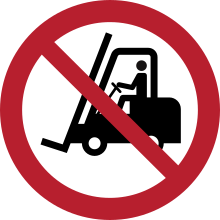Floor conveyor

Floor conveyors are means of conveyance for the horizontal transport of goods that are used on the ground. Counterparts are the overhead conveyors that either hang on the hall ceilings or use rails .
Demarcation
Today the term industrial truck is used in the relevant standards . Other sources also use the term floor conveyor .
Warehouse logisticians basically differentiate industrial trucks into:
- trackless ( pallet trucks , tugs, forklifts, etc.)
- track-bound (including lorries )
- track-guided (including driverless transport systems)
A narrower definition is provided by the professional association regulation " DGUV regulation 68" (formerly BGV D27 ) essentially in paragraph 2 (paragraphs 1 and 2) :
"(1) Industrial trucks in the sense of this accident prevention regulation are means of conveyance that are characterized by their design that they
- walk on the floor with wheels and freely steerable,
- set up for transporting, pulling or pushing loads and
- are intended for internal use.
(2) Industrial trucks with lifting equipment within the meaning of this accident prevention regulation are characterized in addition to paragraph 1 that they
- are set up for lifting, stacking or storing loads on shelves and
- Pick up and set down loads yourself. "
In addition to industrial trucks, there are other types of funding outside of these definitions:
- Lifting equipment such as cranes for vertical transport.
- Shelf conveyor ; they also belong to the discontinuous conveyors; the DGUV excludes them from industrial trucks, as they cannot drive freely in the hallway, but are tied to the respective shelf systems in some form ( rail guide , groove , etc.) and can, if necessary, carry out so-called lane changes.
Further trade association regulations apply to in-house guidance of industrial trucks - in the sense of the DGUV ; In addition to a briefing on the device, motorized devices usually require a floor conveyor license for the device operator, as well as his written assignment. For devices outside the scope of BGV D27, there are usually similar regulations. In public road traffic , the regulations of the road traffic regulations and the driving license regulations must be observed.
Classification of industrial trucks
In terms of a type classification - with abbreviations - the Association of German Engineers divides industrial trucks into seven groups with VDI guideline 3586 :
- Hand tools: in particular pallet trucks
- Petrol and LPG appliances
- Diesel vehicles
- Electric walking devices
- Electric stand devices
- Electric driver's seat devices
- Picking devices , see order pickers , they are used to pick the goods in the usually very extensive warehouses for delivery
In the abbreviation, the first letter stands for the drive, the second for the type of operation and the third for the type of floor conveyor; a fourth letter is added for driverless devices. So called EFM an e lektro- F ahrersitz boost m aststapler; EAVI ( E lektro- A utomatik fork lift trucks, i nduktiv steered).
Abbreviations are used to create or decipher the same in data sheets for industrial trucks according to VDI guideline 2198 and other European standards.
In addition, according to DIN 15140, a distinction can be made between four main groups when handling forklifts with driver's seat:
- Front forklifts : Forklifts that pick up their load from the front, set it down and transport it self-supporting .
- Reach truck : load is picked up and set down from the front; but (also partially) transported within the wheel base (between the wheels).
- Four-way forklift truck : Load is picked up and set down from the front. The load is carried inside the wheel base. The direction of travel can be changed by 90 degrees while stationary.
- Lateral forklift or seated stacker : Load is picked up and set down on the side, but is transported within the wheel base.
The industrial trucks - within the meaning of DGUV regulation 68 - also include other devices (in addition to common handheld devices, stacking devices, powered vehicles, etc.), including:
- Bed movers for hospital beds
- Driverless transport vehicles
- Cross-country skiers , for the ground level transport of several z. B. Euro pallets at the same time
- Straddle carrier ( container handling )
- Reach stacker (container handling)
- Narrow aisle truck = VNA ( engl. Very-narrow-aisle), for feeding shelf systems such. T. automated
- Truck for internal transport
See also
Web links
- Training and commissioning of the drivers of industrial trucks with driver's seat and driver's cab
- Trade journal "Hoists and Conveyors"
- Trade journal "F + H conveying and lifting"
- German Institute for Standardization eV on industrial trucks
Individual evidence
- ↑ Baumann, Baumgart, Kähler, Lewerenz, Schliebner; Logistic processes - jobs in warehouse logistics; ISBN 978-3-44100360-1
- ↑ BGV D27: Accident Prevention Regulations for Industrial Trucks ( Memento of the original from January 15, 2011 in the Internet Archive ) Info: The archive link was automatically inserted and not yet checked. Please check the original and archive link according to the instructions and then remove this notice. at www.bgbau-medien.de


